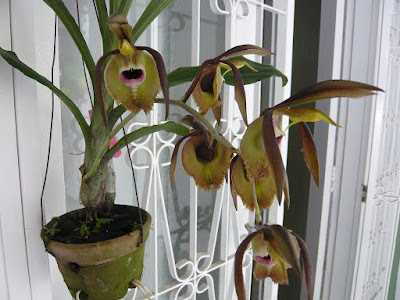Catasetum incurvum is found in Peru; some specimens have also been found in Ecuador and Brazil. It grows in tropical forests in bright areas, exposed to the sun, at an altitude of 100-1700 meters...
Catasetum incurvum also called as The Bent Catasetum, Catasetum saccatum var. incurvum, Catasetum stupendum, is a species of the genus Catasetum. This species was described by Johann Friedrich Klotzsch in 1854.
IDENTIFY CATASETUM INCURVUM
Catasetum incurvum is found in Peru; some specimens have also been found in Ecuador and Brazil. It grows in tropical forests in bright areas, exposed to the sun, at an altitude of 100-1700 meters.
It is a large sized, warm to cool growing epiphyte with fusiform to ovoid-fusiform, 25 cm in height pseudobulbs enveloped by leafless and leaf bearing sheaths carrying 4 to 6, elliptic-lanceolate to oblanceolate, plicate, 3 prominent nerved, 45 cm long leaves.
The Bent Catasetum blooms in the summer and fall on a male, arching to pendent, to 40 cm long, 4 to 5 flowered inflorescence. The flowers can be masculine or feminine, depending on the growing conditions. They are fragrant, up to 12 cm in diameter.
CATASETUM INCURVUM CARE AND CULTURE
Cultural information should only be used as a guide, and should be to be adapted to suit you. Your physical location; where you grow your plants, how much time you have to devote to their care, and many other factors, will need to be taken into account. Only then can you decide on the cultural methods that best suit you and your plants.
Light:
Catasetum incurvum loves a lot of light and needs some hours of direct sun. However, from 12h to 16h (in the winter from 12h to 14h) the direct beams should be lightly shielded. The intensity of light should be 25000-30000 lux to get female flowers, and 20000-22000 lux for male ones. The photoperiod must be 12 hours.
Temperature:
Summer temperatures are 24-27 ° C during the day and 16-18 ° C at night, winter temperatures 22-23 ° C during the day and 14-15 ° C at night.
Humidity:
To get the masculine flowers need 70-75% of air humidity. If it is lower, the female flowers will grow. The humidity around orchids should never fall below 55% for potted specimens, and below 70% for bare root specimens.
Substrate, growing media and repotting:
It is more practical to grow the Catasetum incurvum in a transparent plastic vase, choosing medium-sized pine bark (3-4 cm) as a substrate. In the period when nighttime temperatures are above 16 ° C, it is advisable to place the orchid outdoors, in a place protected from rains, strong winds and direct sunlight from 12h to 16h.
Watering:
This species needs frequent and regular watering (as soon as the substratum has dried well but before it becomes completely dry) since the new jets have started to produce their roots after the rest, until the leaves start to turn yellow in autumn.
Fertilizer:
This species is fertilized every 3 watering with 1/2 of the dose indicated on the vial of a suitable liquid fertilizer for orchids. The fertilizations occur only during the period of growth. Before fertilizing the orchid you have to water it to avoid the harmful effect of the fertilizer on the dry roots.
Rest period:
When Catasetum incurvum has thrown down the leaves, the watering stops completely, because the plant has entered the rest period. However, when resting, to prevent the pseudobulbs from shriveling too much, the substrate surface is slightly vaporized about 2-3 times a month. Most of the old roots die during rest, so it is very important to start again with the watering only when the new jets have generated 1-2 cm of their roots.















Thank you very much for posting these orchid culture info sheets.
ReplyDelete